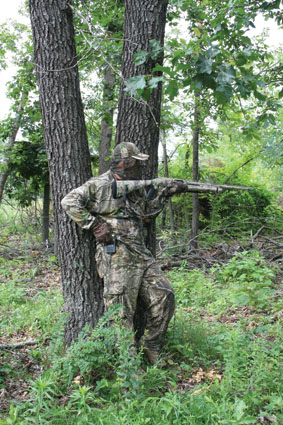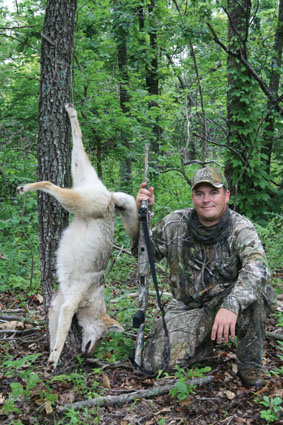 I was introduced to the thick-cover hunting tactics by Western hunters Rich Higgins and Gary Clevenger. They hunted terrain that was similar to what I found back east, but their approach featured one important difference: they stand. Most callers think they are supposed to sit, hunker down, and stay as low as possible. Not necessarily so. When things get thick and tight, stand up. Doing so can change your results when hunting heavy cover.
I was introduced to the thick-cover hunting tactics by Western hunters Rich Higgins and Gary Clevenger. They hunted terrain that was similar to what I found back east, but their approach featured one important difference: they stand. Most callers think they are supposed to sit, hunker down, and stay as low as possible. Not necessarily so. When things get thick and tight, stand up. Doing so can change your results when hunting heavy cover.
Going Vertical
An important factor to consider when hunting thick cover (hardwoods of the East or mesquite thickets out West) is approach. In heavy cover, it’s difficult to predict a coyote’s approach because it is so comfortable in its surroundings that it will often give up the wind advantage in these situations. That makes standing a more effective option for a hunter. I can visually cover much more area than when I’m sitting down, and it allows me to shoot a running target from right to left, or get a shot at a coyote that slips in the back door and then tries to cut out fast.
The Hotspots
Finding thick-cover coyote stands is easy. I try to hunt the coyotes that have already been hunted and conditioned by other hunters or me. When most callers set up stands, they look for a population of coyotes near a big open area that affords good shooting visibility. Gradually the local coyote population diminishes as the less cautious animals are shot and the rest are conditioned to associate the area with danger. Consequently, they’re no longer easily called into open terrain. Most callers will give up calling the area for that year; however, these coyotes are callable if you use a different style. These coyotes are comfortable in thick cover, have never met a hunter there and don’t associate the habitat with danger. Get in there where others fear to tread, and you’ll be amazed at the results.
You can find such hotspots by quizzing local hunters or other callers. Look for evidence of the concentrated presence of coyotes and slip in. Even if an area is hunted heavily, coyotes still leave enough sign to reveal their presence. Don’t worry about running them out of the country, but don’t neglect good entry technique.
Usual Approach
Approaching the stand quietly is critical. A coyote can hear a mouse squeak a quarter-mile away. To communicate with your hunting partner, develop a system of hand signs or sounds such as a smooch or chirp. Whatever you do, don’t talk.
 Working the wind while approaching these stands is just as important as it is in open terrain. Though the wind might not dictate from which direction the coyote will approach, it will determine if the coyotes will remain in the neighborhood long enough for you to call. No sense saturating an area with your scent before you set up.
Working the wind while approaching these stands is just as important as it is in open terrain. Though the wind might not dictate from which direction the coyote will approach, it will determine if the coyotes will remain in the neighborhood long enough for you to call. No sense saturating an area with your scent before you set up.
Use of camouflage is even more vital to the stand up caller. Never neglect hand or face cover, and use 3-D camo when possible. It breaks the human outline, suggesting the presence of just another bush. It also covers up slight movement.
Natural As Always
When you get to the stand location, use natural cover and shadows to your advantage. The perfect setup is against a tree or bush, particularly if you are wearing 3-D camo. Also, shadows from trees can be used effectively in the standup position. If you minimize your movement and display no glint or glare from rifle or gear, coyotes will often approach very close. You are in their “comfort zone” where they don’t anticipate danger. It’s not unusual for coyotes to come to the call at a dead run. Choose a shotgun for this tactic, as it’s almost guaranteed that the action will be close.
Killer Sounds
After arriving at the stand site and waiting until things settle down, stand up and begin calling. Always start with a quiet coax for the 50-yard sleepers (they are there more often than not), then wait a minute and continue with a prey in distress. I often change sounds three or four times in 15 minutes to close it out. The best sounds are distressed rodents, simple prey sounds of a rabbit, and always bird sounds in case there’s a cat in the thick cover. Changing sounds in a sequence is also a key factor in calling conditioned coyotes. It often takes a few different sounds to trigger the wary ones.






